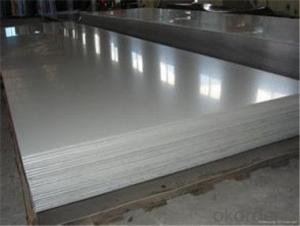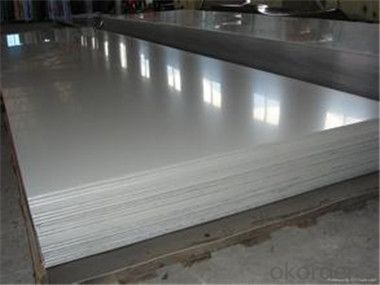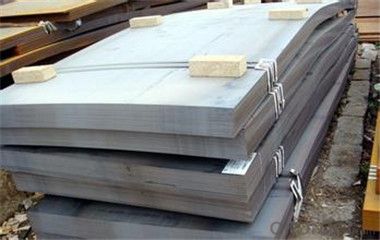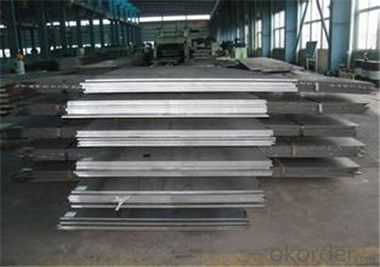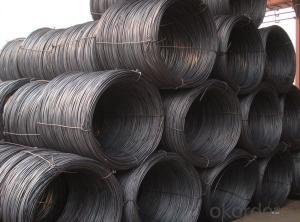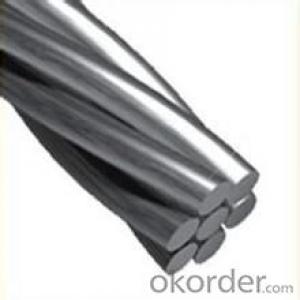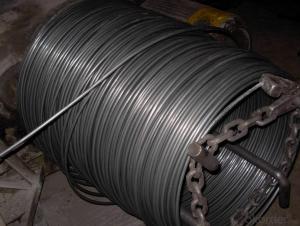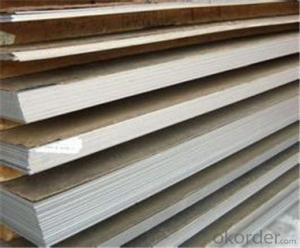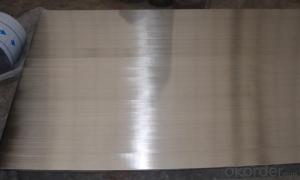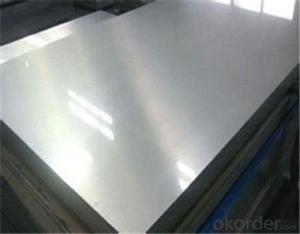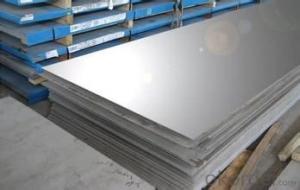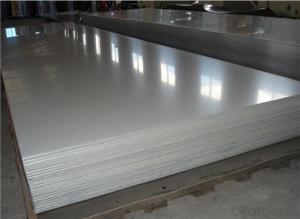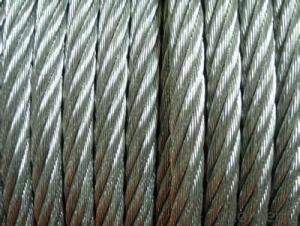Stainless Steel Sheet AISI 316 with Best Quality in China
- Loading Port:
- Tianjin
- Payment Terms:
- TT OR LC
- Min Order Qty:
- 50 m.t.
- Supply Capability:
- 45555555 m.t./month
OKorder Service Pledge
OKorder Financial Service
You Might Also Like
Specification
Description of stainless steel plate:
316L stainless steel containing molybdenum species, the steel containing molybdenum, the overall performance is better than steel 310 and 304 stainless steel, high temperature conditions, when the sulfuric acid concentration is less than 15% or greater than 85%, 316L stainless steel with a wide range of purposes. 316L stainless steel also has good resistance to chloride corrosion performance, it is usually used in the marine environment.
Festures of stainless steel plate:
| Packaging Details: | standard packing to export 4 eye bands and 3 circumferential bands in steel, galvanized metal fluted rings on inner and outer edges, galvanized metal & waterproof paper wall protection disk, galvanized metal & waterproof paper around circumference |
| Delivery Detail: | 15-25 days after received your deposit or to your quantity |
Specifications of stainless steel plate:
Product Name | cr 1219x2438 stanless steel sheet 201 |
standared | JIS, AISI, ASTM, GB, DIN,SUS |
Thickness | 0.2mm~2.5mm |
Size | 1000*2000mm,1219*2438mm or as per customers' request |
Surface finish | 2B, BA, Hair Line, No.1,No.4, Mirror Finish |
Application | Kitchenware, decoration construction and building ornament, product parts manufacturing and stainless steel products tooling and so on |
Payment terms | T/T 30% for deposit, Balance against the copy of B/L; or L/C at sight |
Product Packing | wooden pallet |
Delivery time | within 15-20 working days after we got your 30% deposit |
Attention | FREE SAMPLES can be sent on request. |
Images of stainless steel plate:
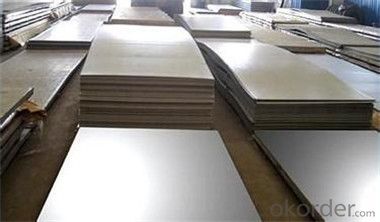
FAQ:
1. What is your package?
Packing situation: standard seaworthy packing or as customer required.
2. How long is the lead time?
Delivery time: 45 days after order confirmed.
3. What payment term do you accept?
Payment: T/T or L/C at sight.
- Q: What are the different types of wire baskets and containers made from steel wire rod?
- Steel wire rod is used to create a range of wire baskets and containers that serve different purposes. These include: 1. Mesh wire baskets: These are frequently utilized for storing and organizing items in residences, offices, and warehouses. Their mesh design allows for easy visibility and ventilation. 2. Wire storage bins: These sturdy containers feature open tops and sides, making them ideal for storing larger items like tools, equipment, or bulk materials. They can be stacked to optimize storage space. 3. Wire mesh crates: Similar to wire storage bins, these crates often come with a hinged or removable lid for added security. They are commonly employed in industries such as agriculture and manufacturing for transporting goods. 4. Wire mesh containers: These larger containers are used to store and transport heavy or irregularly-shaped items, such as machinery parts or construction materials. They are often equipped with forklift pockets or other lifting mechanisms for easy handling. 5. Wire display baskets: These baskets are frequently seen in retail environments like supermarkets or stores. They are designed to showcase products, especially fruits, vegetables, or other goods. 6. Wire laundry baskets: These baskets are specifically crafted for holding and transporting laundry. They typically include a sturdy frame with a wire mesh body to facilitate air circulation and prevent odors. 7. Wire file organizers: These smaller wire baskets or containers are utilized to organize documents, folders, or paperwork in offices or homes. They often incorporate dividers or compartments to separate different files. In conclusion, wire baskets and containers made from steel wire rod offer durability, strength, and versatility in various settings. As a result, they are a popular choice for fulfilling storage and organization needs.
- Q: What is the tensile strength of steel wire rod?
- The tensile strength of steel wire rod depends on various factors such as the composition and manufacturing process. However, on average, steel wire rod has a tensile strength ranging from 400 to 700 megapascals (MPa).
- Q: How is steel wire rod used in the manufacturing of wire springs?
- Steel wire rod is used in the manufacturing of wire springs as it serves as the raw material for creating the wire used in springs. The steel wire rod is first drawn through a series of dies to reduce its diameter and increase its strength. This process, known as cold drawing, creates the wire needed to form the coils of the spring. The resulting wire is then coiled, shaped, and tempered to produce wire springs used in various applications such as automotive, aerospace, and industrial machinery.
- Q: How is the demand for steel wire rod influenced by global economic trends?
- The demand for steel wire rod is significantly influenced by global economic trends. As steel wire rod is a critical raw material used in various industries such as automotive, construction, and manufacturing, any changes in the global economic landscape can have a direct impact on its demand. During periods of economic growth and industrial expansion, the demand for steel wire rod tends to increase. This is because increased construction activities, infrastructure development, and manufacturing output require large quantities of steel wire rod for applications such as reinforcement in concrete, electrical wiring, and fasteners. Conversely, during economic downturns or recessions, the demand for steel wire rod tends to decline. Reduced construction projects, lower consumer spending, and decreased manufacturing activities result in a decreased need for steel wire rod. Industries that heavily rely on steel wire rod, such as automotive and construction, often experience a decline in demand during such periods. Global economic trends also play a crucial role in determining the prices of steel wire rod. Fluctuations in currency exchange rates, trade policies, and supply and demand dynamics can impact the cost of raw materials, transportation, and production, which in turn affects the price of steel wire rod. For instance, increased trade tensions between countries can lead to tariffs or trade restrictions, affecting the availability and cost of steel wire rod in global markets. Additionally, global economic trends can influence the geographical distribution of steel wire rod production and consumption. As countries experience shifts in economic growth, emerging markets may witness a surge in demand for steel wire rod due to their expanding infrastructure and construction activities. This can lead to a redistribution of production facilities and investments in these regions to cater to the growing demand. Overall, the demand for steel wire rod is strongly influenced by global economic trends. Understanding these trends and their impact on industries that rely on steel wire rod is crucial for stakeholders in the steel industry to effectively manage their production, pricing, and market strategies.
- Q: What are the different surface protection materials used for steel wire rod?
- Some common surface protection materials used for steel wire rods include coatings such as zinc, galvanized, or polymer-based coatings. These materials provide a protective layer to prevent corrosion and enhance the durability of the wire rods. Additionally, other surface protection methods such as electroplating or heat treatment may also be utilized in specific applications to enhance the surface properties of the wire rod.
- Q: What are the different types of wire ropes made from steel wire rod?
- There are several different types of wire ropes made from steel wire rod, each designed to serve different purposes and applications. Some of the most common types include: 1. Galvanized Wire Ropes: These wire ropes are coated with a layer of zinc through a process called galvanization. This coating provides corrosion resistance, making them suitable for outdoor and marine environments. 2. Stainless Steel Wire Ropes: Made from high-quality stainless steel, these wire ropes offer excellent corrosion resistance, even in harsh conditions. They are commonly used in marine, food processing, and pharmaceutical industries. 3. Bright Wire Ropes: Also known as ungalvanized wire ropes, these ropes are made from plain steel wire rods without any protective coating. They are typically used in static applications where corrosion resistance is not a concern. 4. Plastic Coated Wire Ropes: These wire ropes have a layer of plastic coating applied over the steel core. The plastic coating provides additional protection against corrosion and abrasion, making them suitable for applications such as gym equipment and hoisting cables. 5. Compacted Wire Ropes: These wire ropes are manufactured using a compacting process that reduces the gaps between individual strands, increasing their strength and durability. They are commonly used in heavy lifting operations and crane applications. 6. Rotation Resistant Wire Ropes: Designed to minimize twisting and rotation under load, these wire ropes are constructed with special strands and core configurations. They are ideal for applications that require precise control and stability, such as suspension bridges and tower cranes. 7. Wire Ropes with Fiber Core: These wire ropes have a core made of natural or synthetic fibers, such as sisal or polypropylene. The fiber core provides flexibility and cushioning, making them suitable for applications that require shock absorption, such as elevators and ski lifts. Each type of wire rope has its own unique properties and advantages, and selecting the appropriate type depends on factors such as the environment, load requirements, and intended application.
- Q: What are the main factors influencing the choice of steel wire rod packaging?
- The main factors influencing the choice of steel wire rod packaging include the weight and size of the wire rod, the required protection and safety during transportation, the storage conditions, the specific industry requirements, and the cost-effectiveness of the packaging solution.
- Q: How is steel wire rod used in the manufacturing of wire for reinforced concrete structures?
- Steel wire rod is crucial in the production of wire used for reinforcing concrete structures. It acts as the primary raw material for manufacturing strong and long-lasting wires that reinforce concrete structures. To begin with, the steel wire rod undergoes a series of processes to convert it into wire suitable for concrete reinforcement. These processes involve cleaning, descaling, and surface treatment to eliminate impurities and enhance its strength and resistance to corrosion. Afterward, the wire rod is drawn into the desired diameter, typically ranging from 5mm to 12mm, through a series of die reductions in order to achieve the necessary strength and flexibility. Once the wire is formed, it is utilized to create reinforcing mesh or rebar. Reinforcing mesh consists of steel wires arranged in a grid pattern to provide consistent and uniform reinforcement throughout the concrete structure. On the other hand, rebar is a long, straight steel rod that is usually embedded within the concrete to provide additional strength and structural integrity. During the manufacturing process, the steel wire rod is often further treated to enhance its bond with the concrete. This treatment, known as ribbing or deforming, involves adding ridges or deformations to the wire's surface to increase its surface area and create a better mechanical grip with the concrete. This ribbing process improves the bond between the wire and the surrounding concrete, ensuring effective load transfer and preventing slippage between the two materials. The steel wire rod used in the production of wire for reinforced concrete structures must meet specific mechanical and chemical properties. These properties include high tensile strength, excellent ductility, and corrosion resistance, as the wire will be subjected to various stresses and environmental conditions once it is embedded within the concrete. In conclusion, steel wire rod plays a crucial role in the manufacturing of wire for reinforced concrete structures. It undergoes various processes to produce high-strength and corrosion-resistant wire suitable for reinforcing concrete. The resulting wire is used to create reinforcing mesh or rebar, which provides additional strength, durability, and structural integrity to concrete structures.
- Q: How is the steel wire rod market segmented by application?
- The steel wire rod market is segmented by application based on the various industries that utilize steel wire rods for different purposes. Some of the main segments in this market include construction, automotive, energy, industrial, and others. In the construction sector, steel wire rods are commonly used for reinforcement in concrete structures, such as buildings, bridges, and highways. These rods provide strength and durability to the structures, making them resistant to various forces and enhancing their overall stability. The automotive industry also heavily relies on steel wire rods for manufacturing various components, including springs, suspension systems, and wire harnesses. The high tensile strength of steel wire rods makes them ideal for these applications as they can withstand the demanding conditions in automotive systems. The energy sector is another significant segment for steel wire rods, particularly in the production of power transmission cables and electrical wiring. Steel wire rods are used to manufacture conductors that efficiently transport electricity over long distances while maintaining minimal loss. In the industrial sector, steel wire rods find applications in a wide range of industries, including machinery, appliances, and manufacturing. These rods are utilized for producing fasteners, bolts, nuts, and other mechanical components that require strength and reliability. Apart from these major segments, there are other applications of steel wire rods in sectors like agriculture, aerospace, and consumer goods. For instance, in agriculture, steel wire rods are used for fencing, trellising, and supporting structures. In aerospace, they are utilized for manufacturing aircraft cables, suspension systems, and other critical components. Overall, the steel wire rod market is segmented by application based on the diverse needs of different industries. The versatility and strength of steel wire rods make them a crucial material in various sectors, enabling the development of robust and reliable products.
- Q: Can steel wire rod be used in the production of wire ropes?
- Certainly, wire ropes can indeed be produced using steel wire rod. Steel wire rod, a semi-finished product, is commonly shaped and pulled into wire for a variety of uses, including wire ropes. To create a robust and long-lasting rope-like structure, wire ropes are usually crafted by intertwining multiple strands of steel wire. Steel wire rod serves as the necessary raw material for manufacturing the individual wires that constitute the strands of a wire rope. In order to meet the mechanical properties and surface finish necessary for wire rope production, further processing, such as drawing and heat treatment, is typically applied to the steel wire rod. All in all, steel wire rod plays a vital role in the production of wire ropes.
Send your message to us
Stainless Steel Sheet AISI 316 with Best Quality in China
- Loading Port:
- Tianjin
- Payment Terms:
- TT OR LC
- Min Order Qty:
- 50 m.t.
- Supply Capability:
- 45555555 m.t./month
OKorder Service Pledge
OKorder Financial Service
Similar products
Hot products
Hot Searches
Related keywords
